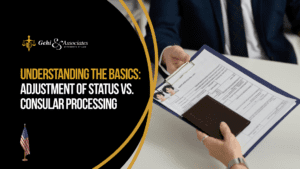
The road to U.S. permanent residency is long and complex sometimes because there are several routes you can take. The option between adjustment of status and consular processing is not just an administrative step; it can affect your timing and experience during the immigration process.
This decision marks a turning point for many people where one path could be more accessible. Location, personal preferences, and specific immigration status are important considerations when choosing which process will work best for you. More than just paperwork consequences, your choice could alter your work permits, travel plans, and long-term residency experiences.
In this guide, we will examine critical aspects of both processes, analyze their significant differences and eligibility requirements, and provide you with the necessary information to make a decision.
About Adjustment of Status
Adjustment of Status allows you to apply for legal permanent residency (LPR) or green card status in America. The process allows those in the United States using a non-immigrant visa or other legal status to apply for a change of their position from temporary residency to permanent resident status (a gateway to citizenship).
What makes Adjustment of Status even more interesting is that you can remain in America while awaiting a decision, which is more hassle-free and less stressful. Also, you can apply for work authorization and travel authorizations during your wait period.
An adjustment of status lawyer concentrates on helping you apply for a green card in the United States. Picture them as legal practitioners you can visit when you need professional help with legal documentation.
About Consular Processing
Consular processing allows you to process an American green card while living in another country. You can do this by contacting a U.S. embassy or consulate in your country and completing the rest of the immigration process. USCIS will approve your petition and forward it to the National Visa Center (NVC), which sends it to an embassy or consulate in your home country.
The process involves several steps, including but not limited to completing documents, medical tests, and an interview. If you pass this, they will give you an immigrant visa that permits you to travel to the United States. Once you arrive, you will receive your green card.
A consular processing attorney specializes in helping U.S. visa applicants file for a green card from abroad. This attorney will help you throughout your application process at a U.S. embassy or consulate office in your home country.
Differences Between Adjustment of Status & Consular Processing
The choice between Adjustment of Status and Consular Processing depends on location, preferences, and specific circumstances. Here are the main differences:
1. Location of Processing
- Adjustment of Status: This process takes place in the United States. If you already hold a valid non-immigrant visa and are in the United States, you can change your status without leaving the country. This process will be helpful if you already live and work in the United States and do not wish to take a break from your stay.
- Consular Procedures: You can carry out this process in a consulate or embassy in your country or another outside the United States. This option is advantageous if you are already overseas and want to complete your immigration before moving to the U.S.
2. Interviews
- Adjustment of Status: USCIS will schedule an interview with you in one of the local USCIS offices closest to your area. During this meeting, USCIS evaluates the material in your application to decide whether you are eligible for lawful permanent residence status. If eligible, the USCIS officer may ask questions about your past, relationship, marriage, and other aspects of your life. Generally, this is the last step before obtaining a green card for people who have yet to have their application denied.
- Consular Processing: Consular officers will interview you in a U.S. embassy or consulate straight from your home country. Interview waiting times are the most significant step in visa issuance, and you should ensure a review of your application, the documentation you submitted, and your qualifications. The officer will check if you meet the eligibility conditions during the interrogation. A successful interview ends with the issuance of an immigrant visa.
3. Processing Times
- Adjustment of Status: Case complexity and individual USCIS service centers can also lead to processing time discrepancies. This process usually takes a few months to a year. Other factors affecting timing include the number of applications to review, your case specifics, and potential requests for additional information.
- Consular Processing: Consular Processing timelines may depend on how busy the embassy or consulate handles your case and to what extent loopholes or inconsistencies exist in your application. This may be faster for some applicants, assuming no lengthy delays at the consular review stage. However, you could be held up by administrative processing or requests for more documentation.
How to Process the Adjustment of Status
Adjustment of status (A.O.S.) processing is a comprehensive procedure that allows those currently in the nation to apply for green cards or lawful permanent residency without leaving. You’ll typically need an Adjustment of Status lawyer to help you. Here is a detailed breakdown of the actions needed:
- Confirm Eligibility: First, make sure you qualify to adjust your status. You will need a proper immigrant petition as well. For instance, you will need a USCIS-approved immigration petition. This means a filled Form I-130 (Petition for Alien Relative) for family-based cases, which shows that the petitioner has already filed on your behalf. It must be either a U.S. citizen or a lawful permanent resident. For employment-based immigrant visas, you need an approved Form I-140 in the employee’s category, confirming employer sponsorship. Verify that your priority date is current by reviewing the Visa Bulletin published monthly by the Department of State, which includes dates for filing applications (along with charts to determine eligibility) based on preference categories and chargeability.
- File Form I-485: This is the primary application process for a green card in the United States. Ensure all the answers on Form I-485, Application to Register Permanent Residence or Adjust Status, are accurate and complete.
Supporting documents you need for the Adjustment of Status process:
- ID Cards: international passport, visa, and Form 1-94 (Arrival-Departure Record Card).
- Documents demonstrating lawful entry (i.e., visa, border crossing card)
- Medical examination results: Form I-693, filled out by a designated medical professional stating that you comply with health requirements.
- Photographs and money: two passport-size photographs; payment of the relevant charges depends on your age and whether or not you include all dependents. These papers are the only documents USCIS will accept when handling your case at the service center.
- Receipt notification: USCIS will send you a receipt notice (Form I-797C) after receiving your application. The receipt number verifying receipt of Form I-485 is shown on this notice. The receipt number allows you to track the status of your application using an online USCIS case status check. The letter will also explain what happens next: any future appointments, potentially additional information requests, and scheduling your biometrics appointment at an Application Support Center (A.S.C.) closest to you. When you attend your appointment, they will collect your fingerprint and signature. This will enable USCIS to perform criminal history checks (when applicable), among other identity verification steps.
- Attend an Interview: You will be given an appointment letter that denotes the date and place of the interview. Your adjustment of status lawyer will help prepare you through mock interviews. On the interview day, in the USCIS offices, an officer will read all the information you have filled out while filing the application form and all supporting documents. Ensure you read over your submission quickly and organize all the papers well before going in for those interviews. The officer is going to verify how truthful and precise your answers are. Be honest and to the point. Following this interview, the officer will approve your petition or come back to request additional information from you as proof of what was said, at which time they could deny it. They will issue you an approval notice and a 10-year-valid green card if approved. If additional evidence is needed, the U.S. employer will receive a request for a review of specific documents or supporting information to finalize their adjudication of your H-1B case file. If your application is denied, USCIS will give you an explanation in writing for the denial.
How to Navigate Consular Processing
Consular processing also requires attention to detail to avoid your application getting delayed or denied. Below is a description of what the process entails:
- Confirm Eligibility: Usually, you should already have an approved immigrant petition from USCIS. Also, your I-130 (Petition for Alien Relative) must be approved if you are applying on a family-based ground, asserting that either a green card holder or a U.S. Citizen filed the petition in favor of the alien applicant. Typically, in an employment-based case, your U.S. employer should have filed and received approval on Form I-140 (Immigrant Petition for Alien Worker) as evidence of their sponsorship.
- Petition Approval and Case Forwarding: USCIS notifies you (or your sponsor) when they approve it and then sends its approval to the National Visa Center (NVC). The NVC will review your case and provide you with a C.O.A. number. Then, they send instructions by post to your email. This includes paying the visa fee and uploading the necessary documents. The NVC is responsible for processing your visa from the U.S. embassy or consulate within your residence country.
- Pay Fees and Submit Documents: The NVC will then send you instructions on how to pay visa application fees. You must pay these fees to process your case, often online or via bank transfer. Once you have paid the fees, collect all the required documents and ensure they are correct.
- Arrange for a Medical Examination and Attend It: In your home country, you must undergo a complete health checkup by a doctor recognized by the United States Embassy. This medical test is a compulsory process of determining your readiness to move to or live in America. It also covers vaccinations and an overall health checkup. Schedule this appointment beforehand; appointments can take a lot of work to find. The results will be returned to you in a sealed envelope. You must then present them during your visa interview.
- Visa Interview: The NVC will arrange a visa interview at the United States Consulate or Embassy in your country of origin. You will be notified about your interview, including the date, time of day, and location. Prepare ahead by reviewing your application and gathering all of the documents. In the interview, a consular officer will ask questions and review your records to ensure they are complete and accurate.
- Receive a Visa Decision: At the end of your interview, the consular officer will decide on your visa application. If granted, the officer will stamp your passport with an immigrant visa. You must enter the U.S. promptly to get a green card, which will be mailed after arrival at your address within the states. If the officer refuses your application, they will explain in writing why.
Make an Informed Decision Today!
The decision between Adjustment of Status and Consular Processing can differ in every person or prospective green card holder’s situation. An experienced adjustment of status lawyer can offer valuable advice tailored to you and your situation so that you can determine the appropriate path to take.




